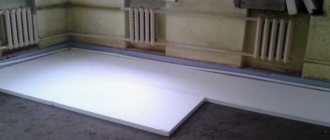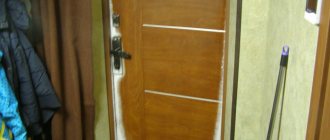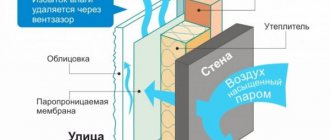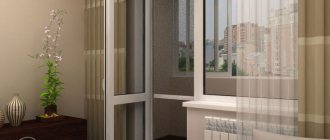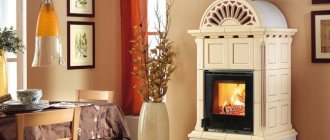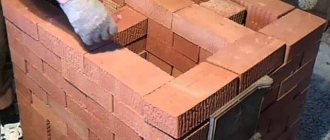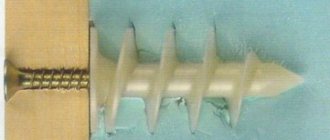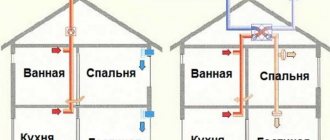Roof preparation
Insulation installation diagram.
When insulating a roof with your own hands, first of all you need to draw up a work plan and decide on thermal insulation materials. Any roof, regardless of the type of structure, consists of an external and an internal part. The roof from the outside (from the street) is called the roof, and the inside part is made up of a frame of rafters and floor slabs. In order for the roof to be warm and last a long time, before starting work, if necessary, you need to carry out repair work, get rid of moisture and all its manifestations on the roof structure: rust, mildew or mold. In this case, the metal parts are cleaned with a metal brush and coated with anti-corrosion agents, and areas affected by mold or mildew are treated with antiseptic compounds.
Regardless of the type of roof, if there is no insulation, the heat loss of the house can be 25%
Based on this, it is important to choose a suitable thermal insulation material. To simplify the installation of insulation with your own hands, the width of the slabs should correspond to the distance between the rafters
Otherwise, cold zones will form in unfilled areas, which will lead to a decrease in the quality of the insulating structure. If you use roll insulation (instead of slab insulation), you can set any width by cutting the roll with a regular wood saw. This will be relevant if the distance between the rafters is different. To keep the roof warm, today there is a wide selection of insulation materials. Each of them has its own pros and cons:
Scheme of a pitched roof with insulation.
- Glass wool is relatively cheap, easy to install, and has good thermal insulation characteristics. It must be used together with waterproofing, as it can lose up to 60% of its thermal insulation properties when wet. It is not a favorable environment for the life of rodents and insects.
- Mineral wool is similar in characteristics to glass wool, but has a long service life (up to 50 years). It is very convenient for DIY installation, as it is available in rolls or in the form of slabs.
- Basalt slabs - the main advantage of this insulation is its high fire resistance. When wet, it loses its thermal insulation properties, therefore, like other fiber insulation materials, it should be protected from moisture.
- Polystyrene foam is one of the cheapest, but no less effective insulation materials. The variety of slab sizes allows it to be used for any roof structure. The disadvantage is the fragility of the slabs, so you need to be careful during installation. In this case, the roof can become a habitat for rodents when using polystyrene foam as insulation.
- Expanded clay - the main advantage is the environmental friendliness and fire resistance of the material. At the same time, it is resistant to biological influences. But the application technology mainly applies to horizontal surfaces (roofs, ceilings), which limits its use. It is also heavier than mineral wool.
- Polyurethane foam is a liquid insulation with fairly low thermal conductivity. It is applied by spraying onto the prepared waterproofing layer. Suitable for cases where you need to quickly carry out insulation measures.
Choice of insulation
This is a responsible task. Thermal insulation should be lightweight, easy to install and at the same time effective. Of the modern varieties of mineral wool, quartz wool best meets these conditions. The thermal conductivity of its light grades is 0.037-0.041 W/(m*°C), which practically corresponds to the performance of polyurethane foam. At the same time, quartz wool is 1.5-2 times lighter in weight than stone wool with similar characteristics.
Thanks to thin (3.5-5 microns) and long (25-30 cm) fibers, it is characterized by high strength and elasticity, therefore it fills the entire space between the rafters without gaps or cracks, preventing the formation of cold bridges.
To insulate the roof and attic floors, it is advisable to use cotton wool in rolls, since it is more convenient to install it in solid pieces along the entire length of the rafters and a compressed roll holds 1.5-2 times more material than in a package with compressible slabs. As a result, the cost of transporting insulation is reduced by 1.5-2 times.
As a rule, insulating the roof of a house with your own hands for permanent residence involves laying mineral wool in two layers, since one layer (maximum 150 mm) is not enough for the harsh Russian winters. In this case, for the first (outer) layer you can use ordinary quartz wool (for example, ISOVER Warm Roof with increased sound insulation and moisture resistance), and for the second - ISOVER Pitched Roof Comfort with a craft vapor barrier coating. The insulation is installed between the rafters with the backing down, after which it is glued to them with ISOVER Paranet adhesive tape.
Mineral wool does not rot or decompose from exposure to moisture
Icing on the roof
As practice shows, snow on the roof does not pose any danger, except for additional weight on the roof frame. The danger from snow appears when it begins to melt, resulting in the formation of ice.
Do-it-yourself insulation
And because of ice, icicles and ice plugs appear in drainage systems. In addition, ice has a negative impact on the quality of the roof covering. And this is not the only unpleasant moment for the roof.
The main reason for the formation of ice is the difference in air temperature between day and night. At the same time, snow melts due to heat transfer from the living space to the attic, and from there to the roof.
For this reason, a warm roof prevents all these problems. Although a lot depends on the material with which the roof is covered.
At this temperature, the air contains a small percentage of humidity, which completely eliminates the possibility of precipitation. And, if there is no precipitation, then there is nothing for ice to form from.
Roof insulation: preparatory stage
Types of insulation fastening.
Let's get down to business and figure out how to make the roof warm. The roof is the uppermost structural part of any building; it is designed to protect the structure from all kinds of external influences. Thermal insulation of the roof is carried out taking into account the local climate and the structure of the building. The technology of roof insulation does not depend on the material from which the house is built: the roofs of both brick and wooden buildings are insulated using the same technology. If the premises are residential, then it is recommended to make the roof insulated both outside and inside, and if the building is used as non-residential, then the last point can be skipped.
Before carrying out roof insulation work, you need to inspect the roof structure and eliminate all faults (if necessary, replace damaged areas with new ones). In addition, it is necessary to eliminate mold on the entire surface of the roof, treat it with an antiseptic or other special agent that would prevent the appearance and spread of mold and fungi. Eliminate all faults in wiring, plumbing and other communications. Done? Then it's time to make your roof warm.
Roof lightning protection
When talking about roof insulation, one cannot help but touch upon such an aspect as lightning protection. No matter how durable the covering material with a super protective layer is, lightning is quite capable of burning through it. And since it is laid on a wooden sheathing, melting and burns can cause a fire. Therefore, creating protection to intercept a lightning discharge and redirect it to the ground is necessary.
Houses with a metal roof do not need to install lightning rods; for them, it is enough to provide a down conductor made of thin steel wire and its grounding
Lightning protection device
There are two types of lightning protection - internal and external. The internal one protects all electrical appliances in the house from overvoltage. The cheapest and easiest way of internal protection is to turn off electricity in the house or at least electrical appliances from energy sources during a thunderstorm. External lightning protection is designed to meet a lightning strike at the roof, conduct it along a safe path (down conductor) and neutralize it in the ground.
Internal lightning protection protects electrical appliances from overvoltage, and external protection protects the roof from lightning discharge and possible melting of the covering material
The external lightning insulation scheme is quite simple. It is easy to do it yourself using a gas apparatus and clamps for attaching the down conductor.
The lightning protection system is not a very complicated device, so you can easily and quickly do it yourself
This protection system consists of the following elements.
- Lightning rod (lightning rod) - “bait” for lightning in the form of a galvanized, copper or aluminum pin with a diameter of approximately 12 mm and a height of 0.2–1.5 m, installed at the highest point of the roof. You can replace the pin with a lightning mesh - important for flat roofs - or with a metal cable laid along the ridge ridge.
- A current conductor is a charge conductor from a lightning rod to a ground electrode, made of steel wire Ø 6 mm, descending from the roof along the walls of the building and secured with clamps or staples.
- Ground electrode is a device that ensures contact of the conductor with the ground. This can be a welded structure made of angle bars and pipes buried in the ground, a metal barrel, a sheet of iron, or steel reinforcement driven into the soil. For the ground electrode to work effectively, the soil around it must be moist. Therefore, it is recommended to periodically moisten it with water during drought, and even better, drain wastewater into this place.
Every year before the start of the rainy season, you need to inspect the lightning rod, checking all fastenings. Loose fasteners should be tightened. Once every 5 years it is necessary to open the grounding device and check it for the depth of corrosion. If rust has covered ⅓ of the ground electrode, it needs to be replaced.
Video: DIY lightning rod, budget option
In this article, we looked at the issues of roof insulation so that you can navigate the variety of materials available today to solve this problem. But you need to understand that even perfect insulation of the roof structure will not give the desired effect without suitable protection of the foundation, walls, floors and ceilings. Only a set of isolation measures will create truly comfortable living conditions in the house. Good luck to you.
The need for roof insulation
How to make the roof warmer to significantly reduce heat loss at home? First of all, you need to choose the right insulation materials and definitely adhere to the installation technology. A well-insulated roof increases the thermal efficiency of a house by 15%, making it possible to create an attic into a room suitable for year-round residence.
Especially great demands are placed on the heat insulator of the attic roof of residential buildings located in areas with cool winters
. The roofing layer of summer attics or used attics includes a thinner insulating layer. The roof, under which an unused attic is located, in most cases is not insulated - thermal insulation is installed on the attic floor or ceiling of residential premises. A warm, non-residential attic is well ventilated, which prevents rotting of the wood elements of the roof frame.
When installing pitched and flat roofs, various roof insulation options are used.
Materials for insulating pitched roofs
Roof insulation technology involves the use of different materials. Particularly common thermal insulators include mineral wool and fiberglass-based wool (in panels or rolls), polymer board materials - polyurethane foam, polystyrene foam. The rules for their installation are similar, but it must be emphasized that installing slab material is much easier and more comfortable.
Instead of waterproofing, in most cases, roofing material or a waterproofing membrane is used, which is dense for water, but capable of draining water from the insulation. The vapor barrier layer can be made from
:
- roofing felt;
- polyethylene films;
- glassine;
- foil materials placed with foil towards the attic room.
To make a roofing pie with high performance parameters, it is recommended to use a specialized vapor barrier membrane to make a vapor barrier: it removes condensation outside from the insulation and does not allow steam and water to pass inside the roofing pie.
Thermal insulation of pitched roofs
The pitched roof pie is created with insulation along the rafters
It is important to understand how to properly insulate the roof of a house, so as not to allow mistakes that ultimately lead to damage to wooden structures
The most famous insulation material in private housing construction is mineral wool. This is an easy-to-install, non-flammable material that you can purchase at a low cost. But the design of the fleece itself helps the accumulation of moisture, which causes a significant decrease in the quality of the thermal insulation of the material, and after some time it incites rotting of the components of the rafter system
Likewise, when creating insulation, it is important to provide for proper ventilation and waterproofing and vapor barrier of the roofing pie
Installation of a pitched roof heat insulator is created from the attic side during construction work or roof repairs. If repair work is underway, before laying the insulation you need to check the condition of the rafters - rotting parts need to be replaced with new ones. It is also worth finishing all wooden structures with a fire-retardant composition.
The pitched roof pie includes
:
- final roof covering;
- hydrobarrier (layer of material for waterproofing work);
- heat insulator;
- vapor barrier;
- interior finishing (optional).
Proper thermal insulation of a roof requires a good exchange of air, for which it is necessary to create layers of air between
:
- under-roof waterproofing and roof covering;
- insulation and water barrier;
- vapor barrier and internal lining (if provided).
Air circulation (removal and free inflow) is provided thanks to specialized vents, one of which must be located in the roof overhang, and the second - under the ridge.
Why is it recommended to insulate roof slopes?
For those home owners who plan to use the attic space as a full-fledged living room or even just a warm storage room, the question should not even be raised. None of the roofing coverings are able to create an effective thermal insulation barrier that would provide a comfortable temperature level
Moreover, not only protection from winter cold is important. A large roof area exposed to the sun’s rays “catches” a huge amount of thermal radiation in the summer, and unbearably hot conditions can be created in the attic.
So the word “insulation” should be considered in a broader sense - the term “thermal insulation” is more suitable.
Without reliable thermal insulation, converting an attic space into a full-fledged room is simply impossible
And if you don’t plan to use the attic, is it worth it to insulate the roof slopes? The matter is, of course, the owner’s, and many prefer to do without this stage of construction. But still, such a measure, although it causes certain additional costs, seems reasonable.
Firstly, it is worth thinking about the energy efficiency of the entire building as a whole. It is no secret that the roof structure accounts for up to a third of all heat losses in a house. This problem can be partly solved by enhanced thermal insulation of the attic floor. But if we add to this the insulation of the roof slopes, then the maximum energy efficiency mode is achieved, which ultimately leads to the effect of significant savings on energy consumption. Secondly, with proper insulation and the accompanying hydro- and vapor barrier of the “roofing cake”, the structural elements of the rafter system will be significantly less exposed to external influences - temperature, humidity and biological. And this, of course, will significantly increase the durability of this site, and the entire building as a whole. Thirdly, almost any thermal insulation material has the properties of absorbing the propagation of sound vibrations
Thus, insulating roof slopes also provides a good soundproofing effect, which is especially important for “noisy” materials such as corrugated sheets, slate, roofing iron or metal tiles.
Insulated roof slopes are also good protection from noise caused by heavy rain or hail
We advise you to study - Penofol. specifications
And finally, fourthly, a good owner should always think “strategically,” that is, for the future. Who knows, it is quite possible that in a couple of years there will be a need for additional space, and the previously insulated attic, without traces of freezing and exposure to dampness, will only have to be “ennobled” and brought to the required degree of comfort. Converting a “cold” attic space that has repeatedly experienced seasonal fluctuations in temperature and humidity into a comfortable room will be extremely difficult. And sometimes for this you even have to dismantle the roofing and make changes to the rafter system with sheathing in order to fulfill all the necessary conditions for insulating the “roofing cake”.
Isn't it better to deal with this issue right away?
Types of roof insulation for a modern house
The final stage in the construction of the frame of any building is the installation of the roof, the quality of installation of which determines the comfort and coziness of the premises, as well as the durability of the entire building. A reliable roof over your head means preventing up to 30% of all heat loss in a building, insulating it from internal condensation and precipitation. Important aspects of the durability and efficiency of roofs are considered to be correctly selected and laid protective layers - waterproofing, thermal insulation and vapor barrier.
In a roofing pie, each layer performs its assigned function, provided that they are placed in the correct order
Each of them is located strictly in its designated place and carries a certain functional load, on which the performance characteristics of the roof depend.
- The waterproofing layer protects the under-roof space from the penetration of atmospheric moisture. It is laid along the outer edge of the rafters, fixed with counter-rails and sheathing. A significant condition for proper installation is the presence of a ventilation gap between the waterproofing and insulation.
- The thermal insulation layer is designed to protect interior spaces from the summer heat and eliminate heat loss through the roof during the cold season. The insulation is laid between the rafter legs in such a way that its inner surface does not slightly reach the upper edge of the rafters, thereby creating a ventilation duct necessary for good ventilation of the roof.
- Vapor barrier membranes or films protect the insulation from warm and moist steam from the room below. They are hemmed along the inner edge of the rafters and secured with slats or finishing materials, for example, clapboard, drywall, etc.
Installation options
Insulation of an unheated attic
The simplest type of roof insulation device is thermal insulation of an unheated attic, since insulation of roof slopes is irrational. The most reasonable thing in this case is to insulate the attic floor. Structurally, it is performed as follows:
- by attaching a vapor barrier to the joists with an overlap from below, they create an obstacle to moving steam;
- insulation is placed between the joists;
- so that you can move on the thermal insulation, it is either covered with a continuous flooring, or “paths” are laid from boards.
Thermal insulation must be constantly dried, so ventilation holes are provided in the gables, and waterproofing is installed under the roofing material to protect against possible leaks.
Insulation of a warm pitched roof
Thermal insulation of a used attic or residential attic is somewhat more complicated. The insulation design, which also includes thermal insulation of slopes, is as follows:
Vapor barrier
Necessary to minimize the penetration of vapors from residential premises into the thermal insulation. The vapor barrier film consists of several layers of polyethylene in several layers and a reinforcing grid made of polyethylene or polypropylene. Fastening is carried out either using a stapler or strips.
It is important to always glue the joints with construction butyl tape.
When installing a vapor barrier, special attention is required to the junction units. They are also glued with butyl tape
Roof insulation
The space between the rafters is filled with insulation of the calculated thickness.
The calculations take into account the thermal conductivity coefficient and operating conditions of the pitched roof. Quite often, mineral wool acts as insulation (density - 30-50 kg/cube
m) and staple fiberglass. For additional fastening of fibrous materials, stretchers made of fishing line or rope are also used. If the height of the rafters is not enough to lay insulation of the required thickness, it is increased by adding timber to the rafters.
Waterproofing insulation
The main function of this layer is protective: firstly, against leaks of the roof covering, and secondly, against condensation that forms on some of its types. For waterproofing use:
- a hydrobarrier made similarly to a vapor barrier made of PE layers with a reinforcing lattice, with the difference that to remove steam, it has additional micro-perforations and cone-shaped punctures. During installation, a gap of several centimeters is maintained between the thermal insulation and the hydrobarrier.
- a superdiffusion membrane, the vapor permeability of which is very high compared to a film hydrobarrier. It is laid without any gaps directly on the heat-insulating layer.
Ventilated gap
An air gap must be provided above the waterproofing layer for ventilation, through which steam that escapes from the insulation through the waterproofing is removed. The vents are located on the roof eaves and ridge.
Substructure for roof covering
As a rule, laying the roofing requires the installation of sheathing - solid or lattice with a certain pitch.
Do-it-yourself roof insulation (step by step)
- The insulation is installed after installing the hydro-windproof membrane. It is mounted from below, from the attic side, between the rafters and from the bottom up. With multi-layer insulation, all layers of thermal insulation material are laid with the seams staggered. If the thickness of the required layer of thermal insulation exceeds the height of the rafters, then they are built up with bars of the required thickness, which are stuffed perpendicularly.
- A vapor barrier film is mounted on the bottom of the rafters. It is attached to the rafters with overlapping horizontal stripes, with the blades overlapping by 100-150 mm, using a construction stapler or nails with a wide head. The joints and places where the film is attached are sealed using vapor barrier tape or reinforced construction tape.
When laying insulation, it is important to ensure that it is installed against the rafters
The disadvantage of using conventional film as a vapor barrier is the numerous tears and punctures during its installation. Even an experienced builder will not notice everything; as a result, the insulation may get wet in places. Therefore, for high-quality vapor barrier, we recommend using specialized membranes, for example, ISOVER Paranet (B).
This is a durable two-layer vapor barrier, which is installed with the smooth side facing the insulation and reliably protects the roofing cake from fumes. The rough inner surface allows you to retain drops of condensation that form in heated rooms in winter.
Choosing a material for a cold roof
However, it is impossible to mount insulation closely to such a film. The fact is that when it comes into contact with the insulation, the film loses its insulating properties and the insulation actually gets wet. So, if in the future you plan to equip and insulate an attic or attic, it is better to use a waterproofing membrane.
When installing a cold roof, you can use all traditional materials as a covering, which do not require a solid base. However, the optimal solution, according to experts, is profiled sheets or metal tiles, which are technologically advanced, durable and reliable roofing materials.
Steel profiled sheet
The simplest solution for a cold roof in the case of a non-residential building is the use of profiled steel sheets equipped with an anti-condensation coating. This material, which has the structure of synthetic felt, is applied to the back side of the corrugated sheet directly during the manufacturing process.
Between the interwoven fibers of synthetic felt there are many tiny air cavities, due to which the coating accumulates and retains a certain amount of moisture (up to 1 l/sq.m.). As the air temperature rises, it begins to evaporate intensely. In this case, there is virtually no need to install a counter-lattice or lay a waterproofing film.
Installation of a roof made of profiled sheets with an anti-condensation coating is carried out similarly to the installation of conventional corrugated sheets. For installation work, neither specialized tools nor additional devices are needed. When using this material, a 30% cost savings is achieved according to the estimate.
The anti-condensation coating reduces the noise of wind, hail and rain, prevents the formation of mold and mildew, and is easily cleaned under pressure using water to remove contaminants.
2019stylekrov.ru
Vapor barrier
In any living space there is always water vapor that rises from the bottom up, ending up in the under-roof space where the roof insulation is located. which should not be exposed to these vapors.
Therefore, a vapor barrier is a mandatory element that a roof and roof insulation must have. Finishing the walls of an attic or attic space with a material that does not allow vapors to pass through can sometimes prevent their penetration into the insulation, but most often it is necessary to use special films for vapor barriers, which are laid between the thermal insulation and the ceiling, usually adjacent directly to the insulation material.
The most important quality of such films is their vapor permeability, determined by the density of its material and expressed in g/m2 (the higher the density, the more effective the vapor barrier).
In addition, the film must be sufficiently tensile for two reasons:
- When the insulation loses its elasticity, the rafters no longer hold it, as a result of which the weight of the material falls on the vapor barrier, which must withstand such a load;
- High tensile strength allows the film to keep the vapor barrier intact even when mechanical stress occurs in the roof structure.
The following hydro- and vapor barrier materials are used in modern construction:
- Polyethylene films used as hydro- and vapor barriers;
- Polypropylene films, often used for waterproofing;
- Breathable non-woven membranes, usually used as waterproofing.
The main purpose of materials for vapor and waterproofing is to protect the roof from moisture penetration, as well as to maintain the required operating conditions of the insulation under the roof.
Their main functions are:
- Preventing the penetration of moisture into the thermal insulation material, which sharply reduces its properties and often leads to its destruction;
- Participation in the operation of the roof ventilation system. preventing the accumulation of moisture in the thermal insulation material and facilitating the removal of its vapors to the outside.
Waterproofing films should be used when constructing pitched roofs, the covering of which does not form a continuous carpet, such coatings include:
- Tiles of all types;
- Metal roofing;
- Slate.
These films also protect against moisture penetrating from outside during strong winds or slanting downpours.
Vapor barrier films must be used in the construction of both pitched and flat roofs, regardless of the type of coating. They protect the thermal insulation layer of the roof from water vapor penetrating from the interior, formed during human activity and rising into the under-roof space as a result of convection and diffusion.
Types of mineral wool and their features
Mineral wool can be called a kind of veteran in the field of thermal insulation. It appeared on Russian markets more than half a century ago. Since then, manufacturing technology has undergone changes, resulting in improved technical characteristics. There are three types: slag wool, glass wool and stone wool. Let's talk about each of them in more detail - this will allow you to decide which one to choose.
It is made from special fibers, the thickness of which is only 5-15 microns, and the length can reach 5 cm. These elements give the material high elasticity and strength. Therefore, it is often used for finishing complex pitched structures. However, you should be extremely careful when working - if small glass fibers get under the skin, it will cause serious irritation. Don't forget about PPE - gloves, hats and especially goggles.
Let's highlight the main technical characteristics:
- Thermal conductivity - from 0.03 to 0.05 W/m*C (depending on density).
- The maximum heating temperature is 450 degrees Celsius (less often 500).
- The minimum operating temperature is minus 60 degrees. This suggests that glass wool can be safely used to decorate a private house in almost any region of the globe (with the exception of the far north, where the temperature often drops below this mark).
- Moisture absorption when immersed in water for a day - 1.7%
We advise you to study - Types of siding for cladding a house - vinyl, base, metal, photo + video
It is made from special blast furnace slag, with a thickness ranging from 4-10 microns and a length of up to 16 mm. The main property of slag is residual acidity, due to which the insulation has an aggressive effect on metals in conditions of high humidity. Therefore, it is highly not recommended to use it if there is contact with iron structures.
In addition, this substance strongly absorbs moisture. Therefore, it is not recommended to use it for the exterior decoration of a private house. If there is still a need to use it, you will have to create additional waterproofing. The slag fibers are very fragile, so it is difficult to work with.
In terms of technical characteristics, it is also inferior to its more advanced “brothers”:
- Thermal conductivity - from 0.045 to 0.048 W/m*C
- Maximum heating temperature - 300 degrees
- The minimum operating temperature is minus 50 degrees.
- Moisture absorption when immersed in water for a day - 1.9%
Stone or basalt wool
Now in most cases, when they say mineral wool, they mean the basalt analogue, since it has the best technical indicators:
- Thermal conductivity - from 0.03 to 0.0412 W/m*S.
- The maximum heating temperature is 1000 C.
- The minimum operating temperature is minus 190 C.
- Moisture absorption when immersed in water for a day is 0.9%.
This suggests that it can be used not only in private, but also in industrial construction. Adding here the highest density (it may differ from one manufacturer to another), moisture and frost resistance, we can say that this is an excellent insulation for roofing, capable of withstanding any climatic vagaries and extreme conditions.
It can be used with equal success both for a simple flat roof and for multi-level pitched structures. There are no additional components in the composition, which will allow it to withstand sudden temperature changes. For private use, it is sold in rolls or sheets with a thickness of 5 to 20 cm. It is also sold in loose form.
There are disadvantages common to all varieties of cotton wool. The most important of them is the inconvenience of work (the need to protect the skin). Inhalation of the smallest fibers is unacceptable. Despite its solid density, it is relatively fragile, and a cut piece may simply tear during installation. Another disadvantage is the presence of phenol in the composition. When heated, it begins to release, and its fumes are dangerous to health. To protect yourself from these harmful effects, you can cover the surface with PVC film; this is especially easy to do on a flat roof.
Calculation of roof thermal insulation, how many materials are required
The thickness of the thermal insulation of the roof, according to SNiP, must compensate for the energy losses of the building, so it is determined on the basis of the thermal conductivity coefficient of the selected material, but not less than 20 cm. If the thickness of the supporting structure is not enough to organize appropriate insulation, then a more efficient material with a low degree of thermal conductivity is used for thermal insulation.
To calculate the amount of insulation, it is necessary to measure the roof and determine its total area. Then it all comes down to simple arithmetic operations: divide the roof area by the total area of insulation in one package and multiply by the required number of layers. An additional 10% for cutting is added to the rounded number of packages.
Let's look at an example of how many packages of 6 m of insulation are needed to thermally insulate a roof of 80 m2.
80/6 x 3=40 packs +10%= 44 packs.
Thus, with these initial data, 44 packages of thermal insulation material will be needed to insulate the roof.
Roof insulation thickness and thermal insulation calculation
What should be the minimum thickness of roof insulation? This is the question asked by everyone who has ever thought about building an attic. Detailed information with calculation formulas and generally accepted state standards can be found in SNiP II-3-79 “Construction Heat Engineering”. We will briefly try to explain in human language the technology for calculating the thermal insulation layer of the attic floor.
For a certain type of insulation, the thermal insulation layer is selected individually. In the case of the most popular insulation based on basalt mineral wool, the thickness should be at least 200 mm. As the first layer, you can use 100 mm thick insulation, then lay two more layers of 50 mm each with an overlap. This closes all “cold bridges” and significantly increases the efficiency of thermal insulation.
In other words, the size of the thermal insulation layer is affected by its density and ambient temperature.
Roof insulation
One of the stages in the construction of wooden houses is the installation of roof insulation. Why is this necessary? The answer here will be unambiguous, roof insulation is, first of all, the protection of its structural elements from unfavorable factors, such as: – moisture; – wood rotting; – formation and reproduction of fungal diseases of wood; – evaporation (condensate).
Wood is a fairly strong and durable material, and in this it is perhaps the leader among its analogues. However, all its unsurpassed quality properties are preserved only in the complete absence of moisture. This means that in order for the wooden structures from which the roof is constructed to last a long time and be structurally indestructible, it is necessary to ensure the most favorable conditions - waterproofing the roof, as protection from moisture of the structure from all sides.
Types and methods of roof insulation
Roof insulation
The modern construction market offers a huge range of waterproofing materials for roofing. However, those of them that perfectly cope with their functions in one region will be absolutely useless in another. Therefore, when choosing materials, it is necessary to correlate their technological characteristics and climate characteristics in the place where the structure is being built. Roof insulation during the construction of wooden houses can be divided into several main types:
– Waterproofing with rolled materials (roofing felt, glass insulation, etc.). This is the most common method of roof insulation and is used on all types of roofs. The material is unwound, sections equal to the length of the roof are formed, which are overlapped layer by layer; – Waterproofing the roof with liquid solutions (bitumen mastic, paint, polyurea, etc.). They are applied using a specialized sprayer over the entire surface of the roof. This method of insulation is used on roofs with a large area, mainly industrial enterprises; – Roof waterproofing with sheet materials – consists in the fact that the entire roof area is covered with sheet materials, for example steel, forming a monolithic covering; – Waterproofing with membrane films. This insulation method is used for flat roofs. Membranes are monolithic rolled products that, due to their unique structure, are capable of allowing air to pass through, but prevent the penetration of moisture and steam, which helps protect the roof from leaking, but at the same time provides the possibility of its ventilation and prevents the formation of condensation.
All house designs presented in the catalog have already been developed taking into account a certain type of roof insulation and corresponding calculations of material costs.
Roof insulation device
When building houses from timber, experts strongly recommend that you take the utmost responsibility when installing roof insulation, observing the sequence of actions, standards and recommendations of design and technical documentation and SNiP. Only with this attitude can we talk about a reliable and durable roof. Professionals will help you not only with choosing the optimal waterproofing material, but will also calculate the required material for construction.
The use of polyurethane foam in roof insulation
One of the modern ways to solve the problem of how to make a warm roof is the technology of covering structures with polyurethane foam. Rigid polyurethane foam has a number of unique qualities:
- Minimum heat loss coefficient.
- It has excellent adhesion and can be applied to almost any substrate.
- Resistant to various types of atmospheric and mechanical influences.
- Practically does not absorb moisture.
- The vapor permeability of the material allows you to avoid the need for additional vapor barrier.
- Low-flammability and environmentally friendly.
These and other characteristics predetermined the wide range of applications of the material. He found his place in the roofing business.
Insulation of floors using polyurethane foam
For these purposes, cheap local materials are usually used, for example, roof insulation with expanded clay or sawdust. These methods, of course, also deserve attention, but the use of polyurethane foam is much more effective for the following reasons:
- Reducing the insulation layer while maintaining all thermal performance indicators.
- Effective filling of the entire area without the formation of voids, absence of cold bridges throughout the entire floor.
- Possibility of use without vapor barrier, which in cases with other materials leads to disastrous consequences.
- Speed of work, one operator is able to process up to 500 m2 of area per shift.
- High speed of hardening and formation of a hard surface.
Roof insulation using polyurethane foam
Roof insulation with polyurethane
The material is unique in that it can be used not only as an insulating element in warm roofs. Nowadays, direct roof insulation with polyurethane foam is increasingly being performed. After hardening, a layer of material applied to an old roof covering not only forms reliable thermal insulation, it is also an excellent waterproofing agent. By covering such a surface with a layer of special paint, you can achieve high-quality protection from ultraviolet radiation, thanks to which such a coating will serve for a long time and reliably.
There are many more ways to use the latest materials in roofing, in particular in insulation work. This is natural, progress does not stand still, and perhaps in the near future, technologies that now seem outlandish to us will be as familiar as the use of mineral wool today.
Lightning protection of a building with a metal roof
The topic of protection against lightning strikes should be discussed separately. It is relevant for buildings where the roofing material is metal.
A lightning protection device on the roof involves equipping the roof with a steel mesh, which is mounted on top of the finishing materials, or under them, provided that the waterproofing and thermal insulation are non-flammable. This mesh performs one function - grounding the roof and does not carry any technical load other than ensuring the safety of people in the building. Lightning protection mesh is installed on a flat roof, on a gable roof, and on roofs of any other structure.
- Residential building and rigid roofing - the advantages of such a roof
- Sandwich panel roofing: technology and installation
- Combined roofing: types and advantages
- Different types of roofing and their features
- How to draw up a roof plan for an industrial building?
- Metal roofing and its classification
- How to calculate the roof slope in percentages and degrees?
Answers on questions
The main classification of roofing coverings distinguishes two types of roofing - soft and hard. Due to their novelty, more attention is paid to soft roofing materials such as.
Another creation of engineering thought recently is a roof made of sandwich panels. If you use sandwich panels on the roof, this will reduce the time required for roofing work.
